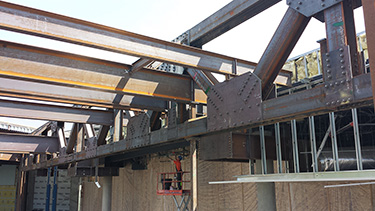|
Subscribe / Renew |
|
|
Contact Us |
|
| ► Subscribe to our Free Weekly Newsletter | |
| home | Welcome, sign in or click here to subscribe. | login |
Construction
| |
 |
March 19, 2015
Massive steel trusses support convention center roof
DCI Engineers
Trusses are a fundamental tool in an engineer’s toolbox — a structurally simple way to transfer weight from one part of a roof to the walls or columns that are designed to withstand the effects of gravity. Most engineers have designed a simple truss by the time they have made it through their sophomore year of college.
But the massive truss that served as a centerpiece for the Spokane Convention Center expansion was not your typical A-frame construction project. At 30 feet tall and 225 feet long — about as long as a Boeing 747 — the truss had to be assembled piece by piece on site and required extensive coordination with the design and construction teams. The result was a visually striking structural feature that overcame several of the project’s design challenges simultaneously.
The expansion added 90,000 square feet to the facility, including added exhibition hall space on the second floor, and ballroom and meeting space down below.
Some assembly required
The convention center’s unique location — an urban environment but adjacent to the Spokane River — limited what engineers could do.
Architectural designs called for the expansion to blend seamlessly with the existing facility, meaning the roofline of the addition couldn’t be taller than what already existed. The proximity to the river meant that the floor of the facility couldn’t go any lower, given the likelihood of flooding.
A traditional column-and-beam layout would have been the obvious solution, but an open floor plan was vital to the future use of the facility, especially the vast exhibition hall, which is designed to accommodate trade shows that would host 10,000 attendees or more.
Logun Rasmussen, an associate at DCI, said the team settled on large steel trusses, which could span long distances without the typical number of vertical supports.
Typically, engineers would call for trusses to be prefabricated off-site and then installed on-site. But the sheer size of the largest of the trusses — two stories tall and made of more than 180 tons of steel — made it impossible to move to the site economically. This meant that the truss had to be designed in sections and pieced together on-site, like a giant set of Legos. In total, the project incorporated 16 long-span trusses.
DCI President Mark Aden said the project’s intricate and varied designs are one of the made it one of the most complicated steel framing projects he has seen in his 30-year career.
“The geometry of the site and building was complicated to say the least,” Aden said. “If there are two pieces of steel the same length in the entire project I’d be surprised.”
The addition is seismically isolated from the original building, but maintaining the open floor plan required getting rid of three existing structural columns in the original building. This meant engineers had to build temporary supports that could hold the existing beams while the new long-span trusses were slid underneath the roof to become the primary support for the building.
Many complexities
Working underground close to a major river posed its own set of challenges. As excavation began, construction crews encountered unexpected subsurface conditions, including car-sized boulders that were a major obstacle to the planned foundation support scheme. Engineers had to use a variety of foundation systems for the final solution, including micropiles, caissons and spread footings.
The project team was able to handle the project’s complexity despite an extremely accelerated construction schedule. It was less than a year between groundbreaking and the ribbon cutting for the new facility.
The project was equally complex from a civil standpoint. Doing major construction near the Spokane River required a special permitting process and careful erosion-control measures to prevent contamination. Any groundwater or stormwater discharged from the site had to be first collected and put through a process called electrocoagulation — where the water is “zapped” with electrical currents to filter out potential contaminants like sediment, oil and heavy metals.
The new designs also greatly improved the utility of the center’s outdoor areas. The center’s west lawn area was plumbed with potable water services, allowing the center to host a wider variety of outdoor events, including food trucks.
The expansion also required moving an 18-inch sewer main that was vital to Spokane’s broader sewer system. The pipe was relocated underneath the Centennial Trail, a multi-use public trail that runs between the river and the convention center.
The new pipe has better downhill slope, addressing maintenance issues the city had been having. Much of the underground utility work occurred below groundwater level, meaning construction crews had to wear hip waders throughout the process.
Though challenging, Rasmussen said the final product is something Spokane can be proud of.
“We had a lot of challenges — tight schedules and big decisions to make,” Rasmussen said. “It’s really rewarding to see it come to completion — it’s a beautiful building.”
As communications coordinator at DCI Engineers, Caleb Heeringa enjoys immersing himself in the A/E/C industry.
Other Stories:



